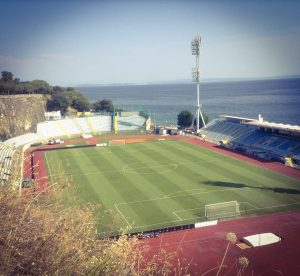The oldest traces of human presence in Rijeka date back to the Palaeolithic and Neolithic periods. Indeed, traces of life from the Bronze and Iron Ages periods have also been discovered in the hills surrounding the city. The development of the town of Rijeka we know today came with to the arrival of the Croats who built what became the location of the current settlement.
Once under Habsburg rule in the 15th century and plundered by the nearby Venetians in the 16th century, Rijeka was eventually annexed to Hungary in 1779. By the mid 19th century – thanks to its coastal location – it had become the site of an esteemed Austro-Hungarian Naval Academy where naval offers were trained.
The post-1848 Croatian-Hungarian Treaty solidified its role as part of the dual monarchy Austro-Hungarian empire.
With the Austro-Hungarian Empire declared defunct after the Great War in 1919, the city of Rijeka and the nearby Sušak was seized by the Italian Nationalists forces headed by Gabriele d’Annunzio when it became an Italian Regency. Eventually, the Free State of Fiume was founded through the Treaty of Rapallo but the nearby Sušak was conceded to the Kingdom of Slovenes, Croats and Serbs.
Known to the Italians as Fiume and to the Slovenes as Reka present-day Rijeka is the chief seaport on western Croatia. Located on Kvarner Bay, a picturesque inlet of the Adriatic Sea, this was a powerful industrial centre within the former Yugoslavian state where shipbuilding, oil refining and manufacturing took place.
It was not until the post-WWII settlement and the Paris Peace Treaty that Rijeka was transferred to Yugoslavia. Rijeka and Sušak were then merged into one unitary city territory.
Since the end of the Yugoslav regime, the city of Rijeka has stagnated like many other former Yugoslav locations. The local economy, once dependent on the sea port and numerous factories, has declined and many once powerful isolated industries have gone out of business or found profit hard to come by in an increasingly global world.
But what Rijeka never lost was its geographic location, surrounded as it is by rugged terrain with mountains that rise steeply just a few kilometres inland from the shores of the Adriatic Sea. Nowadays the city is known for its role in the thriving Croatian tourist economy which hits overdrive during the summer months and for the local football team – HNK Rijeka.
HNK Rijeka
Given the city of Rijeka has changed hands between the Austro-Hungarians, the Italians, Yugoslavs and Croats so the identity of football in Rijeka has also changed considerably over the years.
Originally the first team to play in the city was HŠK Victoria, a football club based in Sušak then as mentioned a separate town. HŠK Victoria played its football at the location of a disused quarry; a location which eventually became the Stadion Kantrida.
In 1925 large capacity stands were built on the location by a newly established local Italian club U.S. Fiumana who went on to use the stadium between 1926 and 1945 while competing in the Italian league system. This club competed for one season in the top tier of the Italian Divisione Nazionale in 1928.
However, after World War II the city of Rijeka and its surrounding area became part of SFR Yugoslavia and as a result, both U.S Fiumana and HŠK Victoria were dissolved.
Out of the rubble of the war came a new club called NK Kvarner which was established on 29th July 1946 as Sportsko Društvo Kvarner and known to the Italians as Società Sportiva Quarnero.
This club’s official name was changed to Nogometni Klub or NK Rijeka on 3 June 1954.
With the establishment of the new Croatian state after the breakup of the former communist Yugoslavia, many clubs started to integrate and utilise the name ‘Croatia’ in the club title. Dinamo Zagreb, for example, became Croatia Zagreb for a short while starting in 1993. In the summer of 1995, the Rijeka club management added the adjective Hrvatski to the club’s official name making the club the current HNK Rijeka.
Stadium Kantrida
The Stadium Kantrida is situated within a disused quarry surrounded by the spectacular sea shore, beaches and steep high cliffs. Consistently ranked as one of the unique stadiums of the world the stadium is easily identified given its surroundings, beauty and atmosphere generated by the home Armada fans.
Huge floodlights were introduced in 1975 these integrated into the rock face above the ground giving an extra dimension of identity to night games at the stadium.
 Alas, the Kantrida in its present known form will soon be no more if only in appearance. Since although the location will remain the look and open feel will change after its demolition in 2018.
Alas, the Kantrida in its present known form will soon be no more if only in appearance. Since although the location will remain the look and open feel will change after its demolition in 2018.
At a cost of €25, the work will oversee major reconstruction over several years as the unique location is adjusted for the modern age of football. A new state-of-the-art stadium will eventually rise from the ashes and this will contain just over 14,000 covered seats enough to satisfy the safety standards to UEFA category 4.
Given the open nature of the current stadium, the new creation will contain extra space for the disabled, VIP visitor’ lounges, sponsorship suites and media rooms. Modern technical solutions such as Wi-Fi and visual screens will also be integrated into the stadium to enhance the match experience.
While the reconstruction work goes on HNK Rijeka will play football at the Stadion Rujevica and this location high above the Kantrida will serve as a temporary home ground for matches in the domestic and European competition. This stadium is actually part of the training camp used by the club containing as it does numerous training pitches within an integrated security enabled complex.
See images from Rijeka here
